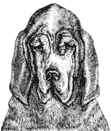 | Bloodhounds: King of the
Trackers Tracking Ability of Bloodhounds Tested |
 | Bloodhounds: King of the
Trackers Tracking Ability of Bloodhounds Tested |
 September 5, 2003
September 5, 2003Behind the sleepy eyes of a bloodhound is an amazing smelling machine. Stories about the fantastic abilities of bloodhounds and other dogs to track down criminals are common. The police in some countries use dogs to track lost people, find illegal drugs and match suspects to a crime scene. Although these stories point to a magnificent canine sniffer, there are no scientific studies that have examined the ability of dogs to track scents...until now. Dr. Lisa Harvey and her husband, Jeffrey Harvey, tested the tracking abilities of eight bloodhounds in a variety of weather conditions. To lay a trail, two people were given a map to follow. Both people started walking at point "A" and traveled to point "B." At point "B," the two people split up and each walked to a different point "C." After each person reached point C, they were picked up by a car and driven away. On the ride away from point C, they were careful not to cross over their trail. After 48 hours, the people were brought back to point C by car where they hid. At this time, the bloodhounds were brought to point A where they were exposed to the scent of one of the walkers and the tracking began.
The Experiment The trail marker (red) walked with a partner. The partners split up at point B and walked to point C. After 48 hours, a bloodhound smelled a sample of the scent from the trail marker and started to track. |
 Dr. Lisa Harvey is an instructor in the Department of Biology at Victor Valley College (Victorville, CA). She also works with police agencies that need her expertise in handling bloodhounds. Jeffrey Harvey is an officer with the San Bernardino Police Department.
 |
The dogs were tested on five different trails at three-week intervals.
The five trails were made in three different environments:
Dogs were divided into two groups: veteran and novice. Veteran dogs were
those who had 18 months or more training and had worked at least one trail
with a law enforcement agency or search and rescue group. Novice dogs had
fewer than 18 months of training.
For all five trails, novice dogs successfully tracked 53.3% of time and the followed the wrong person of the trail marking pair once. Veteran dogs were successful 96% of the time and never tracked the wrong person. There were no differences in the success rate even when the tracking was done in weather conditions with varying temperatures and humidity levels.
Dr. Harvey believes that it is unlikely that the bloodhounds can smell the trail marker who is hiding. She is very confident that the dogs did not smell the fresh smell of the trail layer because the bloodhound is not an air scenting dog. Rather, these animals scent mainly by sniffing the ground. Also, each of the dogs followed the trail that the person had walked 48 hours prior: they did not make a straight line for the hidden person. The tracking abilities of these dogs are truly remarkable! Imagine being able to use only your sense of smell to follow a trail that is two days old. These animals must form perceptions of the world very different from our own. | |
Reference and further information:
|
| GO TO: | Neuroscience In The News | Explore the Nervous System | Table of Contents |
![[email]](./gif/menue.gif) Send E-mail |
 Fill out survey |
 Get Newsletter |
 Search Pages |
 Take Notes |